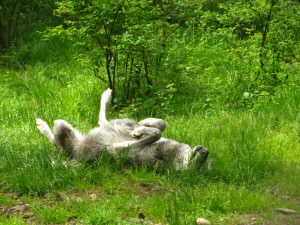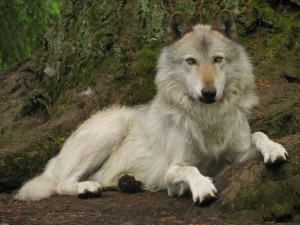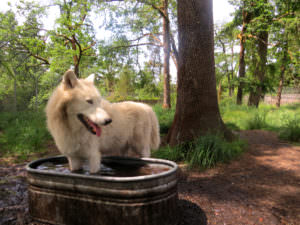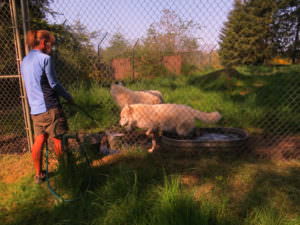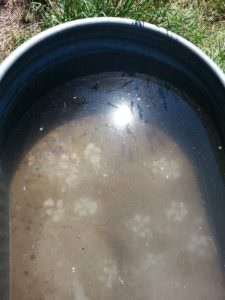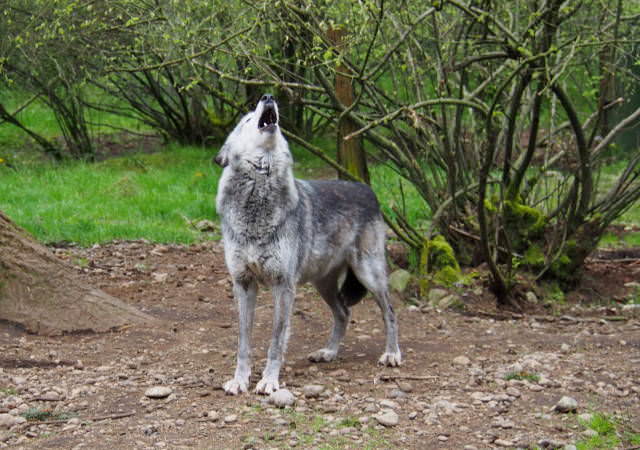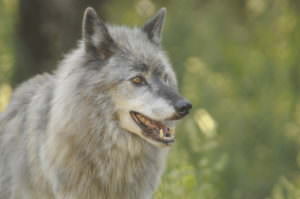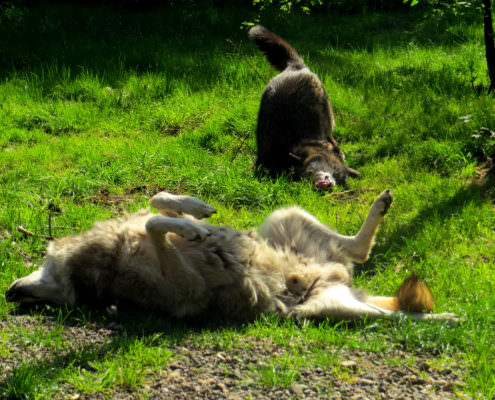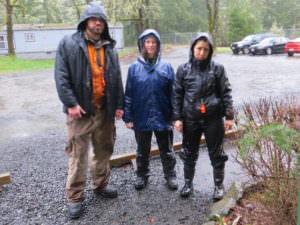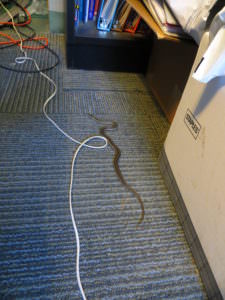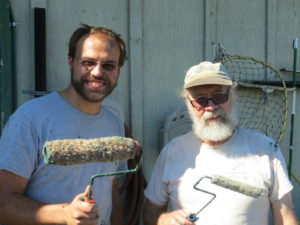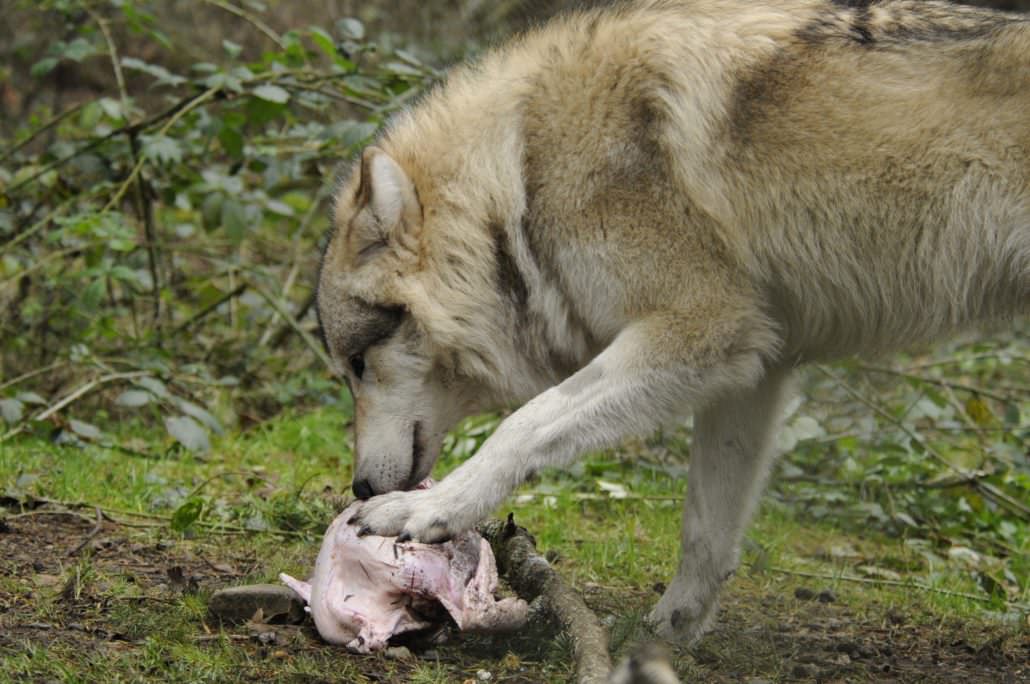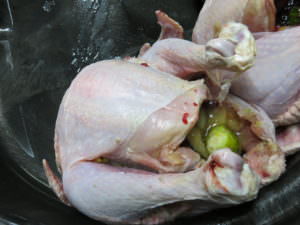Posts
Why do Wolves (and Dogs) Roll on Stinky Stuff?
The following blog was written for the Environmental Nature Center in Newport Beach, CA by guest blogger Skie Bender of Wolf Haven International. Skie is Wolf Haven’s Education Outreach staff person and she has a series of presentations about wolves scheduled throughout Southern California in 2015. CA SCHEDULE.
Riley's spirit continues in our hearts
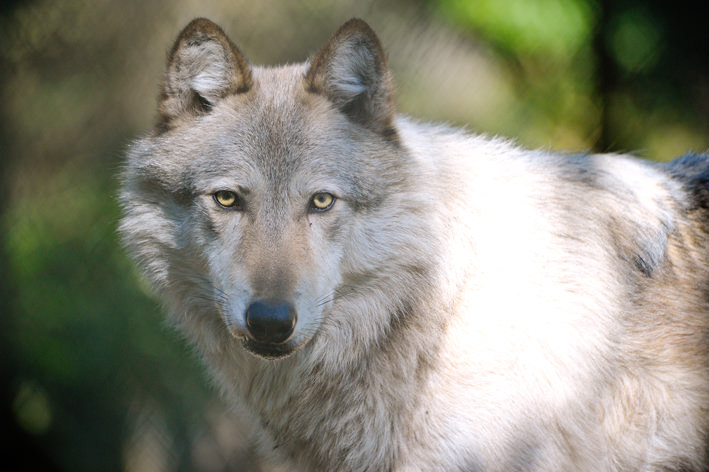
Our friend Riley
photo by Julie Lawrence/Wolf Haven International
It is with a heavy heart that Wolf Haven writes that our friend Riley passed away earlier this month. Riley was only seven years old and was healthy and happy. His passing was very sudden and unexpected and left us all in a state of great sadness.
During a routine morning walk through the sanctuary by animal care staff on Friday December 12, Riley was found lying on his side not moving. It was apparent that he had passed away during the night. The day before he died, Riley was his usual happy, playful self. Two weeks earlier he had been introduced to a new companion, a female wolf named Ukiah, whose brother had died. The two of them were forming a fast friendship and could be seen nose to nose wagging their tails, playing a little and lying quietly next to each other in the middle of their enclosure.
The day he passed he had been given a special treat, a small sheep carcass donated to Wolf Haven by a local farmer. Riley did not want to share the carcass with Ukiah at first. He kept chasing her off until he ate his fill and then he moved away to allow Ukiah to enjoy as well.
When Riley was found the following morning, his abdomen was acutely distended; an indication of gastric dilation volvulus (GDV), where the stomach fills with gas and twists on itself. We consulted our veterinarian about performing a necropsy in order to determine the cause of his death. The veterinarian felt that given all of the symptoms and the large amount of food Riley had quickly ingested the day before, a necropsy was not necessary. She explained that GDV, also known as torsion, evolves extremely quickly, making it nearly impossible to prevent and very difficult to treat successfully, especially in wild canids. Riley (as well as our other wolves) received carcasses on a regular basis without any ill-effects, so we are not sure why on this particular day it turned out to have fatal consequences.
It has been an honor to care for Riley and watch him blossom with his first companion Siri and his burgeoning new friendship with Ukiah. He was a little shy and was also playful and mischievous. He will be greatly missed.
Thank you for your generosity, care and support of Riley while he was with us at Wolf Haven. His spirit will continue on in our hearts.
Mowing at The Haven
by Brennan Stoelb, Animal Care Specialist
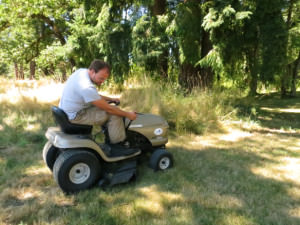 The Pacific Northwest is known for its rainy days, but the summer usually brings lots of sun. As you might guess, this is a great recipe for plants to grow, more specifically, grass. The animal care staff tries to mow the grass in the sanctuary on the footpaths outside of the enclosures on Tuesdays, since we are closed for visits. Our mowing routine is nothing out of the ordinary; one person cuts the roads with the rider mower, two people weed whack closer to the fences and around obstacles. As with everything that needs to get done in the sanctuary, we do it with the animal’s well-being and comfort as the top priority.
The Pacific Northwest is known for its rainy days, but the summer usually brings lots of sun. As you might guess, this is a great recipe for plants to grow, more specifically, grass. The animal care staff tries to mow the grass in the sanctuary on the footpaths outside of the enclosures on Tuesdays, since we are closed for visits. Our mowing routine is nothing out of the ordinary; one person cuts the roads with the rider mower, two people weed whack closer to the fences and around obstacles. As with everything that needs to get done in the sanctuary, we do it with the animal’s well-being and comfort as the top priority.
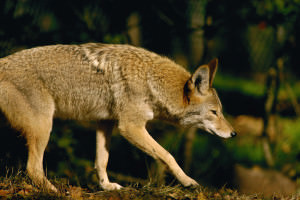 Wolves are neophobic, or afraid of new things. Unlike dogs, wolves are not very brave and outgoing when it comes to new things in their environment. Coyotes are braver than wolves which is why they have been so successful integrating with people and our urban ways. So when it comes to cutting grass, you would expect our residents to stay away from us and the mowers. Guess again! There seems to be two reactions to mowing day; indifference, and curiosity.
Wolves are neophobic, or afraid of new things. Unlike dogs, wolves are not very brave and outgoing when it comes to new things in their environment. Coyotes are braver than wolves which is why they have been so successful integrating with people and our urban ways. So when it comes to cutting grass, you would expect our residents to stay away from us and the mowers. Guess again! There seems to be two reactions to mowing day; indifference, and curiosity.
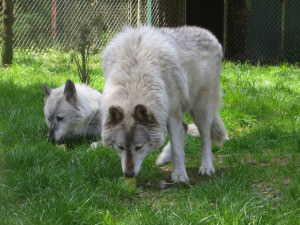 Indifference. There are some residents that just don’t seem to care that the animal care staff is operating loud machinery. Indifference is mostly manifested by them continuing to lie on the ground or carrying on with their normal routine. Some indifferent wolves include Jesse and Shiloh and Mehina and Klondike.
Indifference. There are some residents that just don’t seem to care that the animal care staff is operating loud machinery. Indifference is mostly manifested by them continuing to lie on the ground or carrying on with their normal routine. Some indifferent wolves include Jesse and Shiloh and Mehina and Klondike.
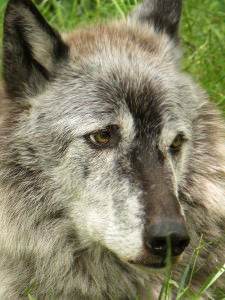 Curiosity. This is the reaction most residents have and it baffles me. Mowing day is met not with fear, but active interest. Even skittish animals seem to have a newfound bravery when the mower is around. Since Shoka arrived at the sanctuary, he has been wary of me. I catch glimpses of him and hear huffs as I walk past during feeding or doing the walkthrough. I do what needs to be done and I move on. But just this morning as I was on the rider mower, I went past Shoka’s enclosure and he was about five feet away from the fence just watching. No huffing. No running to the back of the enclosure. Just watching.
Curiosity. This is the reaction most residents have and it baffles me. Mowing day is met not with fear, but active interest. Even skittish animals seem to have a newfound bravery when the mower is around. Since Shoka arrived at the sanctuary, he has been wary of me. I catch glimpses of him and hear huffs as I walk past during feeding or doing the walkthrough. I do what needs to be done and I move on. But just this morning as I was on the rider mower, I went past Shoka’s enclosure and he was about five feet away from the fence just watching. No huffing. No running to the back of the enclosure. Just watching.
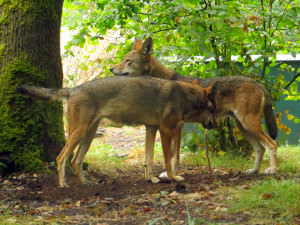 Red wolves Ruby and Tala, while hard to see on visits, are often at the fence in full view while we are mowing the grass. Same goes for the coyotes. Some wolves like Lonnie, will rub the fence line after the mower or weed whacker has passed to get the fresh-cut grass smell. After all, who doesn’t like that?
Red wolves Ruby and Tala, while hard to see on visits, are often at the fence in full view while we are mowing the grass. Same goes for the coyotes. Some wolves like Lonnie, will rub the fence line after the mower or weed whacker has passed to get the fresh-cut grass smell. After all, who doesn’t like that?
Splish Splash
by Brennan Stoelb, Animal Care Specialist, Wolf Haven International
In a recent blog I mentioned that it has been hot here in western Washington. Read it here…… While on most hot days the wolves lay in the shade to keep cool, Wolf Haven also provides other means to beat the heat; splash tubs.
For the animals that enjoy wading in water, animal care places 45 gallon, galvanized tanks in their enclosure. Not every enclosure has a tank because, just like humans, not every wolf likes to get wet. The tubs are about a foot and a half tall, just enough to be below their stomachs. They’ll jump in the tub and begin pawing the water to make it splash. Lakota and Shadow are two residents who love their tubs.
As you might assume, all this playing in the tub can make for some messy water. Every week animal care scrubs the tubs and replaces the dirty water with clean. In some cases the water will be changed more frequently. Daily we top-off the tubs to replace any water that’s been splashed out. With sponges and diluted bleach in hand, we go about the task of cleaning. Not only does dirt and fur cloudy up the water, it’s not uncommon to see someone peeing in their tub. Nothing is better than filling a tub with cool, clean water, only to have them hop in and pee – to each his own, as they say. Sometimes during feeding, a piece of meat will fall the wrong way and land in the tub.
One day when I was feeding a treat to Lakota, a piece fell in the tub. Not to let a little water stand in his way, Lakota stuck his head in the water, over his eyes, and sort of “bobbed” for his treat. Unfortunately, he was unsuccessful. I threw him a replacement, which he ate, but he went back to the tub and pawed the surface of the water, ever hopeful that it may float to the surface.
It surprises some people to hear that wolves can swim. They have webbing between their toes to help them move more easily on snow and uneven surfaces. This webbing also helps when swimming. Wolves will cross streams while chasing prey but
photographers captured one young wolf in Canada swimming to catch a goose. Perhaps his “rubber ducky?”
On Lake Superior in northern Michigan there is an island called Isle Royale. Once connected by a predictable ice bridge in the winter, Isle Royale has become a subject of recent debate. Home to a 56 year study on moose and wolf interactions, the island’s wolves are in decline. According to the annual report, there are nine wolves on the island, two of which are female. Scientists are concluding that the decline is a result of inbreeding both in prey and predator, since no new genetics are regularly coming to the island. To get to the island, wolves would have to swim about 15 miles. In 1997, a wolf from Canada affectionately called, “The old grey guy,” crossed the ice bridge and became a successful breeder. The debate amongst scientists is whether humans should intervene by bringing new genes to the island or let nature take its course. For more information on Isle Royale visit www.isleroyalewolf.org.
So if the heat gets to you this summer, do what the wolves do – and take a dip!
A Picture (and Sound) Worth a Thousand Words
by Wolf Haven volunteer Greg Wellsandt
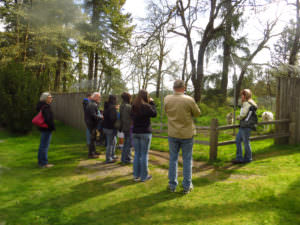
Volunteer Traci leads a group through the sanctuary
On Saturday, Wolf Haven volunteer visit guide Traci was giving the first visit of the day, assisted by her flip chart turner, Greg (that’s me). At Enclosure #5, a howl started way out in the off-visit area. It took a long time to gain momentum, but soon the whole gang was fully engaged in the music making. Caedus and Ladyhawk put on a show at the front of their enclosure as did Klondike and Mehina.
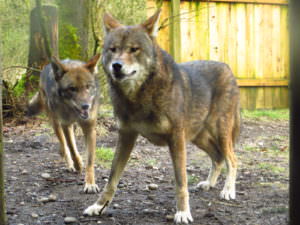
Ruby and Tala, red wolves
Ruby and Tala even made an appearance to lend their unique voices. The howl went on for a long time much to the delight of the visitors who were snapping photos and recording the sounds. Finally, Ladyhawk had enough. She decided it was time to shut Caedus up because she was in the mood to play. She bent over in a quasi-submissive pose and attempted to get his attention. When that didn’t work, she tried to grab his jaw to stop the howling. Caedus gave it a thought for a moment, but went back to what he loves almost as much as eating, howling.
Ladyhawk was not to be deterred and continued to try to get Caedus’s attention. Finally, the howl started to diminish and the two became engaged in a bit of gentle roughhousing. Our sanctuary visitors were treated to a wonderful live display of wolf communication.
The gift of adoption
One way that Wolf Haven raises both funds AND awareness is by offering symbolic adoptions of our resident wolves (and wolfdogs and two coyotes). Adoption levels begin at only $25. You receive a beautiful, professional 4 x 6″ matted photo, an adoption certificate and an official biography of the animal selected.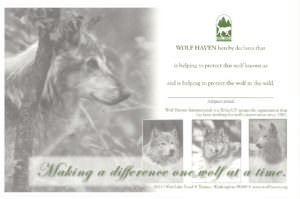
They are also given as gifts; one gentleman routinely “adopts” all of the animals at the sanctuary (50+) for his wife as her Christmas gift. And she LOVES it.
Conservation Groups Collaborate to Celebrate Mexican Wolf
During the last week of March, wildlife advocates, wolf education centers, and captive breeding facilities celebrate the 16th anniversary of the return of the endangered Mexican wolf to its ancestral home in the wilds of the southwest. Missing from the landscape for more than 30 years, the rarest and most unique subspecies of the gray wolf was reintroduced to the wild on March 29, 1998. Hashtag LoboWeek is being used on all social media platforms as we jointly post information about this beautiful and still endangered animal.
 |
| Moss (M1066), a male Mexican wolf at Wolf Haven International |
Thirty-eight years after receiving protection under the Endangered Species Act, the Mexican wolf remains the most endangered mammal in North America and the most endangered subspecies of gray wolf in the world. It is estimated that a minimum of 83 Mexican wolves live in the wild and 248 in captivity in 52 facilities.
What It’s Like to Work With Wolves (part 5 of a 5-part series)
So Why Work with Wolves? by Brennan Stoelb, Animal Care Specialist
When it comes to getting messy, it’s part of the job. I obviously shop at Goodwill. I know that the animals are getting a great variety of food and that care and thought is used to ensure that they remain healthy. It’s also great to know that the road kill is being used for a great cause.
So at this point, we’ve learned that 1) animal care doesn’t play with wolves 2) it can be pretty unpleasant to work in inclement weather and 3) animal care staff not only deal with wolves, but can also be terrorized by the local wildlife (snakes and hornets, for example) and 4) it can be a pretty stinky job. That hits the nail on the head, doesn’t it?
So why do I it? Well, when an animal wants nothing to do with me, doesn’t seek my attention, as in the case of wolves, they are simply doing what they should be doing. It means they are acting as a wild animal. We all want to be wanted and needed, but all they need is to be is left alone. Our residents always arrive at Wolf Haven with varying degrees of human sociability, due to their unique circumstances, and that’s ok. As long as they are comfortable with my presence as I go about my day, performing tasks to allow them a good life, I’m content with that.
As for the weather, very rarely do I look at the forecast. I simply assume that every day the weather will be awful and then I’m never let down. I get to be outside, and I’ll never argue with that.
As for the local wildlife……there is nothing redeeming about snakes and hornets.
THE END
Thanksgiving at Wolf Haven
An annual feast for wolves
Kim Young, Director of Communications (portions of this article were originally posted in the Winter 2012/2013 issue Wolf Tracks magazine; it has been updated to reflect this year’s feast also)
In keeping with tradition, Wolf Haven animal care staff carefully prepared a Thanksgiving turkey for our wolves. The raw birds were stuffed with the usual accoutrements: cranberry sauce, mashed potatoes and gravy, dressing, yams and a lone Brussels sprout.
A row of buckets was lined up, each filled with one of the above-mentioned treats. Armed with ladles, staff members carefully poured a dollop from each bucket into the cavity of the turkey. Soon, the back of the flatbed truck was bulging with stuffed turkeys.
For a few wolves, this was their first Thanksgiving at Wolf Haven International.
It is safe to assume that Samantha, Talulah and our newest resident, Lakota, never experienced a feast like this before. Each wolf approached the meal differently: Shiloh ate every bit of food – except the Brussels sprout. Siri carefully urinated all over her turkey (marinating it?) before eating. London raced to the back of his enclosure with turkey dangling from his mouth – but since he was holding it upside down, all of the goodies fell out during the trip. He left a trail of dressing, yams, cranberry sauce, etc. which his mate Kiawatha tried to scarf up as quickly as possible. Lakota is very food motivated, and he scarfed the entire turkey down in six minutes (you can see the video on YouTube) while his enclosure mate Sequra attempted to cache (bury) her turkey while he was distracted.
It’s hard to say who enjoys this annual tradition more – Animal Care staff or the wolves – but this special meal is one of the many ways that Wolf Haven celebrates the 41 wolves, seven wolfdogs and two coyotes who reside here. As an organization, we give thanks for having the opportunity and space to care for our residents and the Wolf Haven supporters whose generosity makes it all possible.
Everyone enjoys the holidays at Wolf Haven International!
Kim

